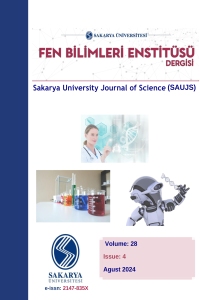Abstract
In this study, a photovoltaic system with an installed power of 10 kWp, which was built on the roof of a school cafeteria in Gümüşhacıköy district of Amasya, was modeled using the PVsyst software and PVSOL software. The real-life data of the system and the production data calculated from the software used were compared. While the actual total electricity production data of this photovoltaic system for 2021 was determined as 12.473 MWh, this value was obtained as 12.912 MWh using PVsyst software and 13.556 MWh using PVSOL software. While there was a 3.40% difference between the estimated production value and the real-life data with the PVsyst software, it was determined that there was a 7.99% difference between the estimated production value and the actual production value of the system as a result of the simulation made with PVSOL. From the production estimates made with two different simulation software, it was seen that the PVsyst software gave results closer to the real-life data.
References
- E. Koç, K. Kaya, “Enerji Kaynakları-Yenilenebilir Enerji Durumu,” Mühendis ve Makina, 56(668), pp 36-47, 2015.
- N. Yılankırkan, H. Doğan, “Türkiye’nin Enerji Görünümü ve 2023 Yılı Birincil Enerji Arz Projeksiyonu,” Batman Üniversitesi Yaşam Bilimleri Dergisi, 10(2), pp.77-92, 2020.
- S. Özbektaş, M. C. Şenel, B. Sungur, “Dünyada ve Türkiye’de Yenilenebilir Enerji Durumu ve Kurulum Maliyetleri,” Mühendis ve Makine, 64, 711, pp. 317-351, 2023.
- Ç. F. Kılıç, “Güneş Enerjisi Türkiye'deki Son Durumu ve Üretim Teknolojileri,” Mühendis ve Makina, 56 (671), pp. 28-40, 2015.
- Turkish Electricity Transmission Corporation (TEİAŞ). https://www.teias.gov.tr/kurulu-guc-raporlari. Last Access Date: 22.04.2024.
- E. Akcan, M. Kuncan, M. R. Minaz, “Pvsyst Yazılımı ile 30 kW Şebekeye Bağlı Fotovoltaik Sistemin Modellenmesi ve Simülasyonu,” Avrupa Bilim ve Teknoloji Dergisi, 18, pp. 248-261, 2020.
- H. K. Demiryürek, U. Arifoğlu, M. Bolat, “Lebit Enerji Güneş Santralinin Pvsyst Programı ile Analizi,” BEÜ Fen Bilimleri Dergisi, 9 (3), pp.1351-1363, 2020.
- M. S. Çınaroğlu, M. Nalbantoğlu, “Şebekeye Bağlı Üç Adet Fotovoltaik Enerji Santralinin PVsyst Programı ile Analizi; Kilis Örneği,” ECJSE, 8(2), pp. 675-687, 2021.
- S. Komrit, F. Zabihian, “Comparative analyses of solar photovoltaic, wind turbine, and solar photovoltaic and wind turbine hybrid systems: Case study of Thailand,” Energy Conversion and Management, 293, pp. 117479, 2023.
- S. Altınkök, S. Karadeniz, A. Altınkök, “Photovoltaic System Design and Analysis at Faculty Scale,” Journal of Naval Sciences and Engineering, 18(1), pp. 91-120, 2022.
- E. E. Dirlik, C. Gezegin, S. A. D. Mohammadi “Comparison of PVsyst, PVSOL and HOMER Simulation Software Results with Real Production Data of Solar Power Plants in Different Provinces of Türkiye,” Journal of Engineering Research and Applied Science, 12(2), pp. 2357-2364, 2023.
- (SEPA, Solar Energy Potential Atlas) Güneş Enerjisi Potansiyel Atlası, GEPA (2021). https://gepa.enerji.gov.tr/MyCalculator/ Last Access Date: 25.04.2024.
- N. Kan Kaynar, “Yenilenebilir Enerji Kaynaklarından Güneş Enerjisinin Amasya İlindeki Potansiyeli,” Bilge International Journal of Science and Technology Research, 4 (2), pp. 48-54, 2020.
- PVsyst Program Interface. https://www.pvsyst.com. Last Access Date: 22.06.2021.
- Meteonorm 7.3 https://www.pvsyst.com/help/meteo_source_meteonorm.htm. Last Access Date: 22.06.2021
- Valentin Software, https://valentin-software.com/en/products/custom-software/. Last Access Date: 06.12.2021.
- YEKDEM, Yenilenebilir Enerji Kaynakları Destekleme Mekanizması.
- https://www.epdk.gov.tr/Detay/Icerik/3-0-72-3/elektrikyekdem Last Access Date: 22.06.2021.
- ETBK, Enerji ve Tabii Kaynaklar Bakanlığı. https://enerji.gov.tr/evced-cevre-ve-iklim-turkiye-ulusal-elektrik-sebekesi-emisyon-faktoru/. Last Access Date: 23.03.2022
Abstract
References
- E. Koç, K. Kaya, “Enerji Kaynakları-Yenilenebilir Enerji Durumu,” Mühendis ve Makina, 56(668), pp 36-47, 2015.
- N. Yılankırkan, H. Doğan, “Türkiye’nin Enerji Görünümü ve 2023 Yılı Birincil Enerji Arz Projeksiyonu,” Batman Üniversitesi Yaşam Bilimleri Dergisi, 10(2), pp.77-92, 2020.
- S. Özbektaş, M. C. Şenel, B. Sungur, “Dünyada ve Türkiye’de Yenilenebilir Enerji Durumu ve Kurulum Maliyetleri,” Mühendis ve Makine, 64, 711, pp. 317-351, 2023.
- Ç. F. Kılıç, “Güneş Enerjisi Türkiye'deki Son Durumu ve Üretim Teknolojileri,” Mühendis ve Makina, 56 (671), pp. 28-40, 2015.
- Turkish Electricity Transmission Corporation (TEİAŞ). https://www.teias.gov.tr/kurulu-guc-raporlari. Last Access Date: 22.04.2024.
- E. Akcan, M. Kuncan, M. R. Minaz, “Pvsyst Yazılımı ile 30 kW Şebekeye Bağlı Fotovoltaik Sistemin Modellenmesi ve Simülasyonu,” Avrupa Bilim ve Teknoloji Dergisi, 18, pp. 248-261, 2020.
- H. K. Demiryürek, U. Arifoğlu, M. Bolat, “Lebit Enerji Güneş Santralinin Pvsyst Programı ile Analizi,” BEÜ Fen Bilimleri Dergisi, 9 (3), pp.1351-1363, 2020.
- M. S. Çınaroğlu, M. Nalbantoğlu, “Şebekeye Bağlı Üç Adet Fotovoltaik Enerji Santralinin PVsyst Programı ile Analizi; Kilis Örneği,” ECJSE, 8(2), pp. 675-687, 2021.
- S. Komrit, F. Zabihian, “Comparative analyses of solar photovoltaic, wind turbine, and solar photovoltaic and wind turbine hybrid systems: Case study of Thailand,” Energy Conversion and Management, 293, pp. 117479, 2023.
- S. Altınkök, S. Karadeniz, A. Altınkök, “Photovoltaic System Design and Analysis at Faculty Scale,” Journal of Naval Sciences and Engineering, 18(1), pp. 91-120, 2022.
- E. E. Dirlik, C. Gezegin, S. A. D. Mohammadi “Comparison of PVsyst, PVSOL and HOMER Simulation Software Results with Real Production Data of Solar Power Plants in Different Provinces of Türkiye,” Journal of Engineering Research and Applied Science, 12(2), pp. 2357-2364, 2023.
- (SEPA, Solar Energy Potential Atlas) Güneş Enerjisi Potansiyel Atlası, GEPA (2021). https://gepa.enerji.gov.tr/MyCalculator/ Last Access Date: 25.04.2024.
- N. Kan Kaynar, “Yenilenebilir Enerji Kaynaklarından Güneş Enerjisinin Amasya İlindeki Potansiyeli,” Bilge International Journal of Science and Technology Research, 4 (2), pp. 48-54, 2020.
- PVsyst Program Interface. https://www.pvsyst.com. Last Access Date: 22.06.2021.
- Meteonorm 7.3 https://www.pvsyst.com/help/meteo_source_meteonorm.htm. Last Access Date: 22.06.2021
- Valentin Software, https://valentin-software.com/en/products/custom-software/. Last Access Date: 06.12.2021.
- YEKDEM, Yenilenebilir Enerji Kaynakları Destekleme Mekanizması.
- https://www.epdk.gov.tr/Detay/Icerik/3-0-72-3/elektrikyekdem Last Access Date: 22.06.2021.
- ETBK, Enerji ve Tabii Kaynaklar Bakanlığı. https://enerji.gov.tr/evced-cevre-ve-iklim-turkiye-ulusal-elektrik-sebekesi-emisyon-faktoru/. Last Access Date: 23.03.2022
Details
| Primary Language | English |
|---|---|
| Subjects | Metrology, Applied and Industrial Physics |
| Journal Section | Research Articles |
| Authors | |
| Early Pub Date | August 2, 2024 |
| Publication Date | August 31, 2024 |
| Submission Date | May 10, 2024 |
| Acceptance Date | July 6, 2024 |
| Published in Issue | Year 2024 Volume: 28 Issue: 4 |
Cite
INDEXING & ABSTRACTING & ARCHIVING
Bu eser Creative Commons Atıf-Ticari Olmayan 4.0 Uluslararası Lisans kapsamında lisanslanmıştır .


